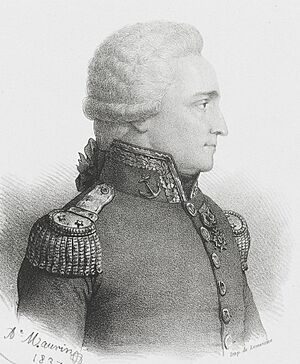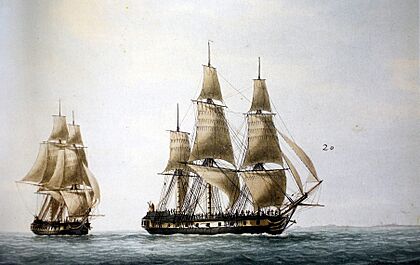Antoine Bruni d'Entrecasteaux facts for kids
Antoine Raymond Joseph de Bruni, chevalier d'Entrecasteaux (born November 8, 1737 – died July 21, 1793) was a brave French naval officer and explorer. He is most famous for his journey to the Australian coast in 1792. His mission was to search for another missing French explorer, La Pérouse.
Antoine Bruni d'Entrecasteaux is often called simply Bruni d'Entrecasteaux or Bruny d'Entrecasteaux. These names combine his father's family name, Bruni, with the name of his family's home, Entrecasteaux.
Contents
Bruni d'Entrecasteaux was born in 1737 in Aix-en-Provence, France. His father was an important member of the local government. Antoine first wanted to become a priest. However, his father encouraged him to join the French Navy in 1754.
He started as a midshipman and became an ensign in 1757. During his early years in the navy, he served in various roles. Later, he became an Assistant Director for ports and naval bases.
In 1785, Bruni d'Entrecasteaux took command of a French naval group in the East Indies. He found a new, safer route to Canton (in China) through the Sunda Strait and the Moluccas islands. This route was useful during certain monsoon seasons. In 1787, he was made Governor of the French colonies of Isle de France (now Mauritius) and the Isle of Bourbon.
The Search for La Pérouse
In September 1791, the French government decided to send an expedition to find La Pérouse. La Pérouse had disappeared after leaving Botany Bay in Australia in 1788. Bruni d'Entrecasteaux was chosen to lead this important search.
He was given two frigates, the Recherche and the Espérance. The Recherche was commanded by Bruni d'Entrecasteaux himself. The Espérance was led by Jean-Michel Huon de Kermadec. A skilled mapmaker, Charles-François Beautemps-Beaupré, joined the team. He would create very detailed maps during the voyage.
The expedition left Brest on September 28, 1791. Bruni d'Entrecasteaux was promoted to rear-admiral. The original plan was to sail to Australia, explore its southwest coast, and then go to Van Diemen's Land (Tasmania). After that, they would sail to Tonga and follow La Pérouse's planned route in the Pacific Ocean.
Exploring Van Diemen's Land
When Bruni d'Entrecasteaux reached Table Bay, South Africa, in January 1792, he heard a rumor. Someone claimed to have seen canoes near the Admiralty Islands with local people wearing French uniforms. Even though this rumor was later denied, Bruni d'Entrecasteaux decided to sail directly to the Admiralty Islands.
First, he stopped at Van Diemen's Land (Tasmania) for water and supplies. On April 20, 1792, they saw land. Three days later, the ships anchored in a bay, which he named Recherche Bay. For the next five weeks, the French explorers carefully explored the waterways and rivers in the area.
Beautemps-Beaupré, the mapmaker, did excellent work. His maps of Van Diemen's Land were so detailed that they were used by English explorers for many years. While surveying the coast, Beautemps-Beaupré discovered that Adventure Bay, Tasmania, was on an island. This island was separated from the mainland by a navigable channel.
On May 16, d'Entrecasteaux sailed his ships through this channel. They discovered and named several features, including Port Esperance and the Huon River. The channel was named D'Entrecasteaux Channel, and the large island was named Bruny Island in his honor.
Journey to the Pacific and Back to Australia
On May 28, 1792, the ships sailed into the Pacific to continue the search for La Pérouse. They explored parts of New Caledonia and the Solomon Islands. They also sailed through Saint George's Channel and sighted the Admiralty Islands. After checking the area, Bruni d'Entrecasteaux decided the rumors he heard earlier were false. He then sailed to Ambon (in Indonesia) to resupply.
Leaving Ambon in October, Bruni d'Entrecasteaux headed back towards Australia. He wanted to follow his original instructions to search the southern coast of Australia. On December 6, they sighted land near Cape Leeuwin and named it Point D'Entrecasteaux.
The weather was rough, and they couldn't find King George Sound. As they sailed east, they found many islands and dangerous shallow areas. They named these the D'Entrecasteaux Islands, which were later renamed the Recherche Archipelago.
On December 12, a strong storm hit the ships. They were almost wrecked but found a safe place to anchor. They landed on the mainland and named the spot in honor of Legrand, who had found the anchorage. Beautemps-Beaupré quickly mapped the nearby islands. They couldn't find fresh water, so on December 18, they continued east. However, the coast became even drier, and their water supply became very low.
Final Explorations and Tragic End
On January 4, 1793, Bruni d'Entrecasteaux had to leave the coast and sail directly back to Van Diemen's Land. This was a bit unlucky, because if he had continued exploring the southern coast of Australia, he would have discovered many places later found by Bass and Flinders.
The ships anchored in Recherche Bay again on January 22. They spent five weeks there, getting water, resting the crews, and exploring the local plants, animals, and geography. Beautemps-Beaupré mapped the northern parts of Storm Bay. He found a river mouth, which he named Rivière du Nord. This river was later renamed the Derwent River by another explorer.
On February 28, d'Entrecasteaux sailed from Van Diemen's Land towards Tonga. He sighted New Zealand and the Kermadec Islands along the way. In Tonga, the local people remembered Cook and Bligh, but they knew nothing about La Pérouse. He then sailed back to New Caledonia.
The search for La Pérouse continued. They explored the Santa Cruz Islands, the Solomon Islands, and the Louisiade Archipelago. They also sailed through the Dampier Strait and along the coasts of New Britain and the Admiralty Islands.
By this time, the expedition faced serious problems. The officers and crew had different political views, which caused tension. Sadly, Kermadec died of tuberculosis in Balade harbor. On July 21, 1793, Bruni d'Entrecasteaux himself died of scurvy near the Hermit Islands in Papua New Guinea.
After his death, the command of the expedition changed hands. The ships eventually went to Surabaya in Java. There, they learned that a new government had taken power in France. The ships were handed over to Dutch authorities. The expedition's papers were later returned to one of the officers, Rossel, who published a book about the voyage.
Australian Places Named After Him
- Western Australia
- Point D'Entrecasteaux34°50′S 116°0′E / 34.833°S 116.000°E
- D'Entrecasteaux National Park 34°36′S 115°56′E / 34.600°S 115.933°E
- South Australia
- D'Entrecasteaux Reef 31°58′S 131°55′E / 31.967°S 131.917°E
- Tasmania
- Bruny Island 43°22′S 147°17′E / 43.367°S 147.283°E
- D'Entrecasteaux Channel 43°15′S 147°15′E / 43.250°S 147.250°E
- D'Entrecasteaux Monument Historic Site 43°16′S 147°14′E / 43.267°S 147.233°E
- D'Entrecasteaux River 43°28′S 146°50′E / 43.467°S 146.833°E
- D'Entrecasteaux Watering Place Historic Site 43°34′S 146°53′E / 43.567°S 146.883°E
Eponyms
A type of lizard found in Australia is named after D'Entrecasteaux. Its scientific name is Pseudemoia entrecasteauxii.
See Also
- European and American voyages of scientific exploration
- Middle Island (Western Australia)
Images for kids





